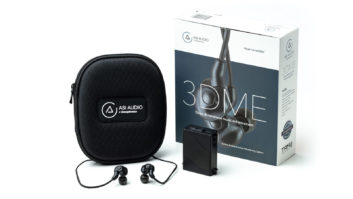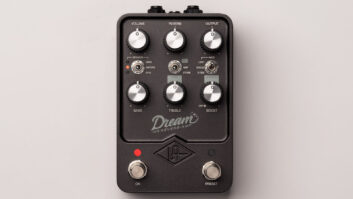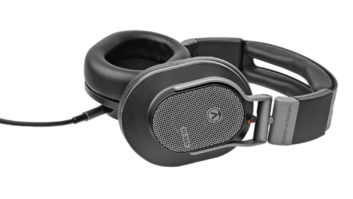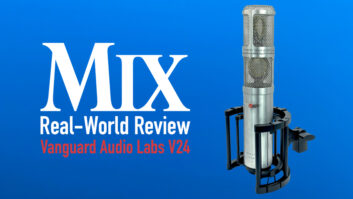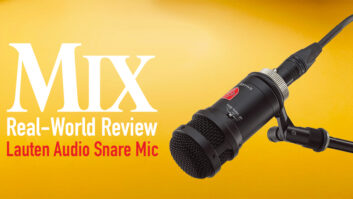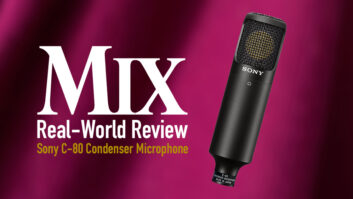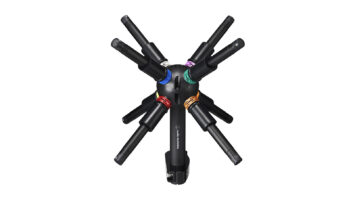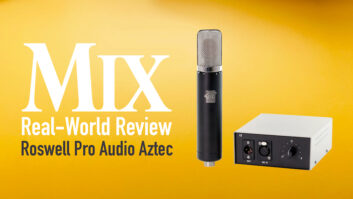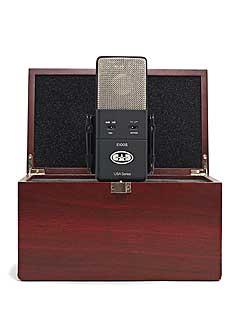
The CAD E100S features a 10dB pad, 80Hz highpass filter and integral shock-mount.
The latest microphone from CAD Audio is the E100S, a supercardioid condenser model engineered and built in the U.S. Intended as a general-purpose instrument and vocal mic, the E100S employs a 1-inch, nickel-plated capsule and CAD Audio’s differential Quadra-FET™ circuitry for low noise and high sensitivity. Although the E100S appears to be similar to previous models from CAD Audio, the mic’s capsule and electronics are completely new. The E100S requires 48-volt phantom power and ships in a padded wooden storage box.
On the front of the E100S are switches for a 10dB pad and an 80Hz highpass filter (6 dbB/octave slope). The shock-mount appears to be permanently attached and includes an extra set of elastic bands. I received two E100S microphones for review and found that the two were sonically very closely matched.
LET’S HEAR IT
I used the E100S for a variety of vocals and instruments, obtaining excellent results on most sources. Acoustic guitar recordings had a high-frequency sheen that worked well in the context of a mix, and a gently finger-picked track revealed no background hiss—a testament to the E100S’ low self-noise. Proximity effect is subtle; moving the mic toward the sound hole slightly augmented the low-frequency response without overemphasizing it, as other microphones sometimes do. The shock-mount—working with what appears to be a rubber suspension holding the capsule within the mic housing—effectively isolated the capsule from vibrations created when players tapped their feet.
Combined with an Avalon AD 2022 preamp and a Universal Audio 1176 limiter, the E100S delivered a male rock vocal that floated perfectly above a dense mix, with a nice body in the low-midrange frequencies and high-frequency detail that required no equalization. (The E100S’ frequency response features a presence peak of about 4 dB at 7 kHz.) Stacked background vocals did not exhibit the exaggerated frequency response bump that’s sometimes apparent when multiple tracks are layered using the same microphone. Popping “p’s” were a bit of a problem due to the open grille, so I’d suggest using an external screen when recording vocals. On a few occasions, the presence peak proved unflattering. For instance, when used on a particular vocalist who’s difficult to record due to the fact that he produces quite a bit of sibilance, his voice sounded overly bright through the E100S.
My criticisms of the E100S are minor. The XLR jack is located on the rear, very close to the mic’s body, and I had a tough time unplugging the mic cable. Every time I pulled the connector out, it banged against the mic—which is a shame because the nicely textured finish will inevitably be scratched. Due to the mic’s size and the somewhat limited maneuverability of the pivoted stand mount, placement was a bit of challenge in tight spaces.
Using the E100S’s as drum overheads wouldn’t be my first choice, but moving them five feet in front of the kit (three-and-a-half feet high) allowed them to blossom as room mics, with great balance between drums and cymbals, and a fat whump from the kick drum. The E100S accurately captured maracas and tambourines without making them sound like someone was crunching a bag of potato chips (which in my experience is sometimes the case with condenser mics). Close-miked toms are absolutely killer with the E100S, with a perfect mix of snap from the stick and head, round tone from the shell and that slight pitch bend that I love to get out of toms: “dooooom.”
IS IT E-SSENTIAL?
CAD Audio has done an excellent job with the E100S. It works with a wide variety of instruments or vocals with very good results, and its low self-noise makes it valuable when recording quiet instruments. It looks like it’s built to withstand some pretty serious abuse (though I did not put it to that sort of test), and it will handle as much SPL as you can throw at it. Though it falls into a crowded price range, the E100S can hold its own against the competition. It’s definitely worth an audition.
Steve La Cerra is a live and studio engineer based in New York.

Click on the Product Summary box to view the CAD Audio E100S product page.
